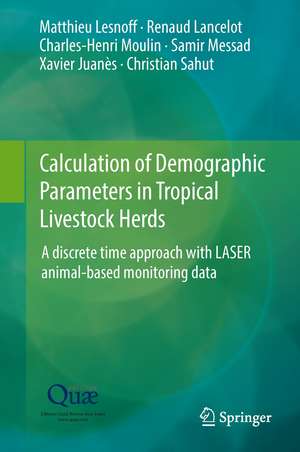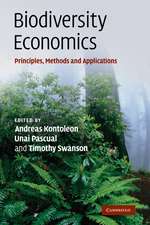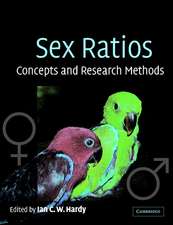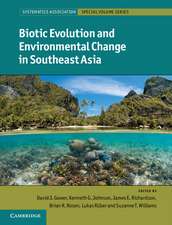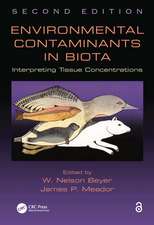Calculation of Demographic Parameters in Tropical Livestock Herds: A discrete time approach with LASER animal-based monitoring data
Autor Matthieu Lesnoff, Renaud Lancelot, Charles-Henri Moulin, Samir Messad, Xavier Juanès, Christian Sahuten Limba Engleză Hardback – 6 iun 2014
| Toate formatele și edițiile | Preț | Express |
|---|---|---|
| Paperback (1) | 631.40 lei 6-8 săpt. | |
| SPRINGER NETHERLANDS – 17 sep 2016 | 631.40 lei 6-8 săpt. | |
| Hardback (1) | 639.41 lei 6-8 săpt. | |
| SPRINGER NETHERLANDS – 6 iun 2014 | 639.41 lei 6-8 săpt. |
Preț: 639.41 lei
Preț vechi: 752.24 lei
-15% Nou
Puncte Express: 959
Preț estimativ în valută:
122.36€ • 127.03$ • 102.03£
122.36€ • 127.03$ • 102.03£
Carte tipărită la comandă
Livrare economică 25 martie-08 aprilie
Preluare comenzi: 021 569.72.76
Specificații
ISBN-13: 9789401790253
ISBN-10: 9401790256
Pagini: 112
Ilustrații: X, 99 p. 33 illus., 23 illus. in color.
Dimensiuni: 155 x 235 x 12 mm
Greutate: 0.39 kg
Ediția:2014
Editura: SPRINGER NETHERLANDS
Colecția Springer
Locul publicării:Dordrecht, Netherlands
ISBN-10: 9401790256
Pagini: 112
Ilustrații: X, 99 p. 33 illus., 23 illus. in color.
Dimensiuni: 155 x 235 x 12 mm
Greutate: 0.39 kg
Ediția:2014
Editura: SPRINGER NETHERLANDS
Colecția Springer
Locul publicării:Dordrecht, Netherlands
Public țintă
ResearchCuprins
1. Introduction.- 1.1. Background and objectives.- 1.2. Animal-based monitoring.- 1.3. A selection of parameters.- 1.4. Organization of the handbook.- 2. Grouping demographic data.- 2.1. Cohort splitting.- 2.2. Pseudo-cohort splitting.- 3. Mortality and offtake rates.- 3.1. One type of removal.- 3.2. Case with two types of removal.- 3.3. Additional points.- 4. Other demographic rates.- 4.1. Reproduction rates.- 4.2. Synthetic rates.- 4.3. Global demographic rates.- 5. Package laserdemog.- 5.1. R software.- 5.2. Functions in laserdemog.- 5.3. Additional points.- 6. Numerical examples.- 6.1. Example 1 – Overall description.- 6.2. Example 2 – More on reproduction rates.- 6.3. Example 3 – Test of a treatment on mortality.- 7. Annexes.- 7.1. Rates p and h in survival analyses.- 7.2. R materials.- 7.3. Structure of tables generated by hsplit and vsplit.- 8. Bibliography.
Notă biografică
Matthieu Lesnoff is a biometrician at CIRAD. He specializes in modelling tropical livestock demography.
Renaud Lancelot is an epidemiologist at CIRAD, with extensive field experience in Africa. He currently coordinates the European EDENext research project on vector-borne diseases.
Charles-Henri Moulin is an animal scientist and professor at Montpellier SupAgro. He specializes in livestock farming systems analysis in Mediterranean (France, Morocco) and tropical (Senegal, Mali, Brazil) areas.
Samir Messad is a biometrician at CIRAD with long experience in tropical livestock data management and analysis.
Xavier Juanès is a computer scientist at CIRAD. He has developed the LASER software and many other information systems for managing tropical livestock data.
Christian Sahut is a computer scientist at CIRAD, specializing in Web platform development.
Renaud Lancelot is an epidemiologist at CIRAD, with extensive field experience in Africa. He currently coordinates the European EDENext research project on vector-borne diseases.
Charles-Henri Moulin is an animal scientist and professor at Montpellier SupAgro. He specializes in livestock farming systems analysis in Mediterranean (France, Morocco) and tropical (Senegal, Mali, Brazil) areas.
Samir Messad is a biometrician at CIRAD with long experience in tropical livestock data management and analysis.
Xavier Juanès is a computer scientist at CIRAD. He has developed the LASER software and many other information systems for managing tropical livestock data.
Christian Sahut is a computer scientist at CIRAD, specializing in Web platform development.
Textul de pe ultima copertă
Ruminant livestock (cattle, small ruminants, and camels) have a determinant economic role in many tropical developing countries. In traditional low-input farming systems, demographic parameters (e.g. reproduction or mortality rates) are important indicators for estimating and modelling herd dynamics and production, and impacts of farming practices or environmental risks (droughts, epizootics, etc.). Although such parameters have been extensively described in the literature on tropical livestock, many descriptions only rely on empirical presentations of formulas without clear methodological justifications. This book fills this gap, presenting the main concepts used to define and compute demographic parameters for tropical livestock, such as probabilities and hazard rates of occurrences and competing risks. It is based on the LASER software, a relational database management system specifically designed for animal-based monitoring surveys. It also provides an introduction on R, the free statistical software (http://www.r-project.org) used for the computations.
It is intended for researchers, engineers, technicians, or students dealing with demographic parameters of tropical ruminant livestock in various fields such as animal science, epidemiology, or economy. It will also be valuable for readers wishing to enhance their understanding of definitions and formulas found in the literature, and it will guide them in their applications.
It is intended for researchers, engineers, technicians, or students dealing with demographic parameters of tropical ruminant livestock in various fields such as animal science, epidemiology, or economy. It will also be valuable for readers wishing to enhance their understanding of definitions and formulas found in the literature, and it will guide them in their applications.
Caracteristici
Fills a gap in the market on presenting the main concepts used to define and compute demographic parameters for tropical livestock Description of the use of LASER software Enhances the understanding of definitions and formulas found in literature and gives guidance in their applications Includes supplementary material: sn.pub/extras
